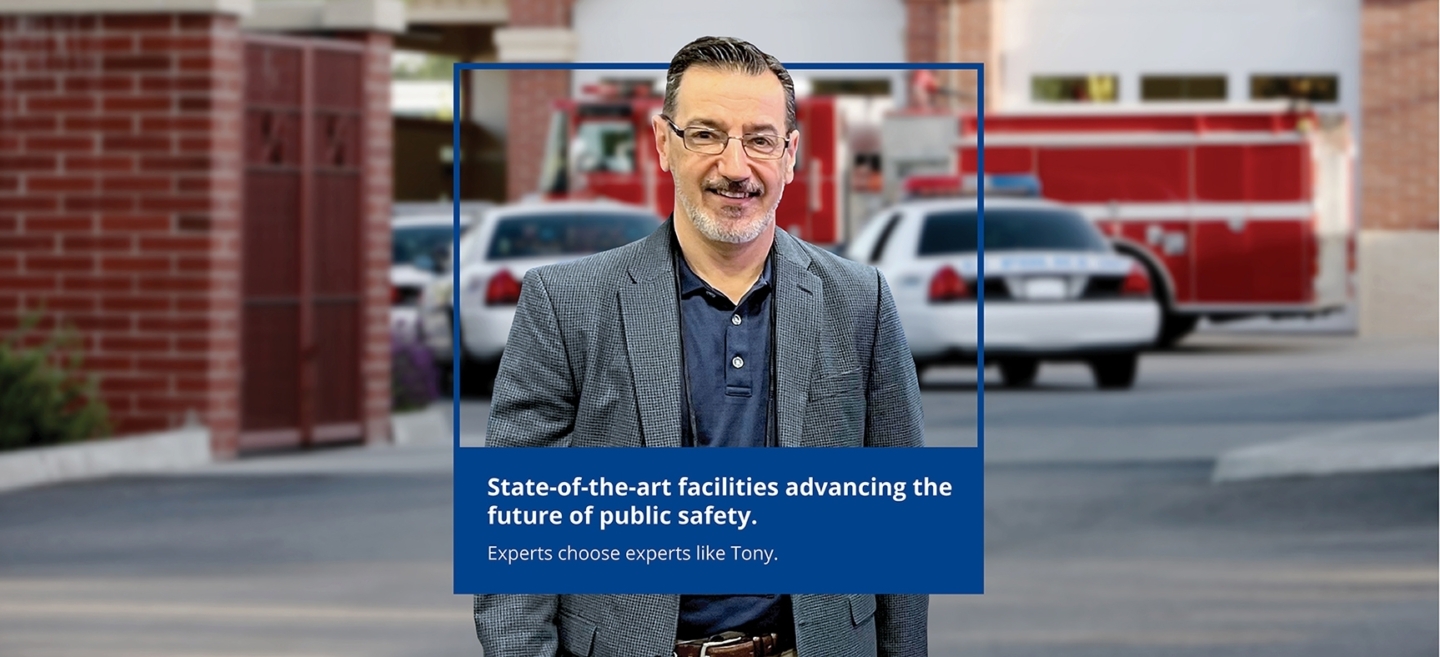
Colliers’ Associate Director, Anthony “Tony” DiLuzio, has more than 30 years of experience providing project management services, overseeing design and engineering professionals, preparing construction documents, and coordinating engineering disciplines. In that time, he has worked on more than 20 public safety projects, from stand-alone police and fire stations to combined public safety facilities.
We sat down with Tony to learn more about his experience in public safety and how the design and construction of these unique facilities have evolved over the years.
How did you end up focusing on public safety facilities?
I worked on my first police station early in my career. It was a small, 11,000 square foot single story building. The department was moving out of the basement of their town hall. Like many old communities in New England, their Police Department had formed out of what was initially a single constable or sheriff in town. They had a couple of cruisers and three or four auxiliary policeman that would come out and respond to big events, but mostly it was just the sheriff and an administrator working out of the town hall basement. The gratitude they had after moving into their new building was so rewarding and I knew I wanted to keep working in this sector.
I’ve seen it time and again in most of the projects I’ve work on. You might be dealing with a chief who came on the force decades ago and has been working in the same old building, watching it decay around him. His goals and objectives are to retire and leave a better station for the next generation to have. They are always so appreciative of what we do and the facility we’re able to deliver to them. It really can’t compare to any other type of building I’ve ever worked on.
What was the largest/most complex public safety project you’ve worked on?
That would be the Gardner Police Station in Massachusetts. It was a complex project because the only site available in town to build the station on had a stream and a brook running through it. We ended up burying the brook and stream in culverts and building a structural slab over the culverts with cleaning and maintenance accessibility built into it. We then built a 30,000 square foot police station above it.
During the design stage the police were concerned, as they were coming out of an old building that had been prone to floods, mold, and water filtration. They were concerned there would be trout coming up through the floor drains, but we assured them that would not happen.
We built a very good environment for the aquatic life living underneath the building, protected it, put a shell and membrane over it and built a very good police station above it.
How have public safety projects changed over the last 20 years?
The biggest change when it comes to police stations is the technology. When you watch an old TV show you might see a group of officers in the roll call room with a pad ready to take notes. Now they all have iPads, laptops, and body cameras. We have to be able to capture all the information their equipment is collecting, so servers have increased. Radio rooms have increased. These days you might have 14 different channels they’re corresponding and communication on.
The other thing that has changed is dealing with evidence and detainees. All those things are regulated by state and national standards that you have to meet. You have chain of custody on evidence that must be followed from the minute evidence is bagged, tagged, and stored. You have to keep a record of who’s touched it, where it went in the building, and you want as few steps as possible during the process. All of that must be considered when designing a new police station in ways it wasn’t in the past.
When it comes to fire stations, the biggest change has to do with environmental factors. There has been ever increasing rates of cancer among firefighters. When they’re called out to a scene, they deal with all kinds of elements such as chemicals, asbestos, and biologicals. It gets all over them and historically they would get back in the truck and drive back to the station. Their clothes and the truck are contaminated and now those contaminates could be migrating throughout the rest of the building.
The biggest change in fire station design has been the separation of hot and cold zones and making sure there is no cross-contamination. You don’t want to suck any of the contaminates to the clean side of the building, so decontamination areas have become much more complex than they ever used to be.
What is your favorite part about being a project manager?
Like a lot of project managers, I started out in architecture. Unfortunately, the more you progress in your career, the less you get to work directly with, and get to know, your clients. As a project manager, I was able to get back to working directly with the police chiefs, fire chiefs, and those who are actually using the facilities that we build.
A project manager is integrated in the project from the very beginning. We get to hear the clients talk about what they want and don’t want out of their new building. They may mention a need for an area to clean something or perform some function and we transfer that knowledge to the construction representatives and other contractors working on the project. It’s so rewarding when they finally move in to hear them say, “Wow, we brought that up way back in the beginning and now it’s here.”
————————————-
Click here to learn more about how Tony and Colliers Project Leaders can help with your next capital construction project.




